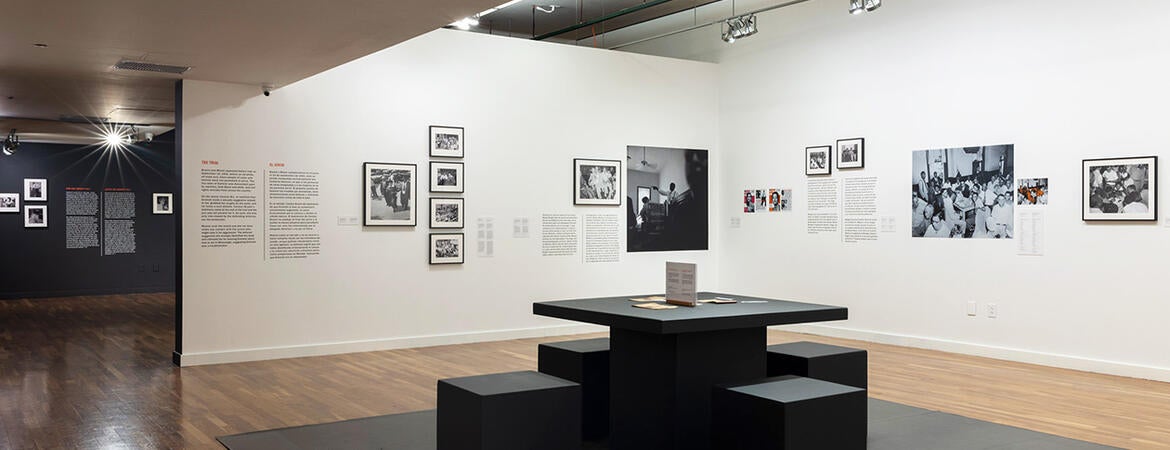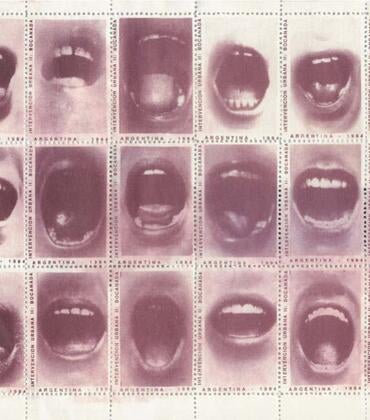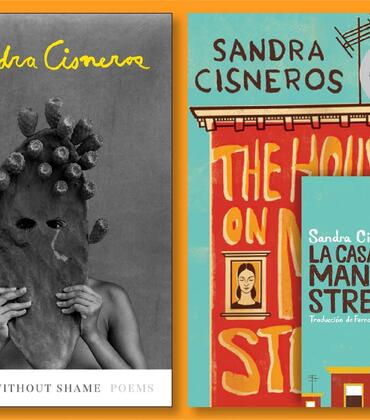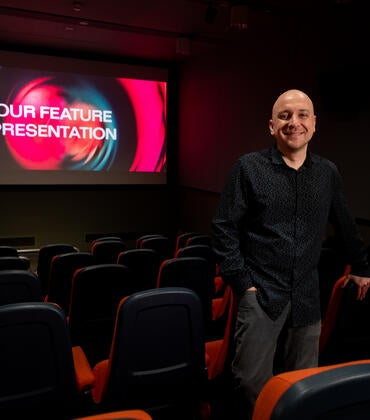
When discussing the exhibition, “The Impact of Images: Mamie Till’s Courage from Tragedy,” Douglas McCulloh says, “Her decision to have an open casket and insist Black photographers be present wasn’t just courageous.”
The casket was for her 14-year-old son, Emmett Till, “who was abducted, tortured, and lynched in Mississippi in 1955, after being accused of offending a white woman,” the exhibition text reads.
McCulloh, senior curator and interim executive director for UCR Arts, which includes the California Museum of Photography, pauses before a photograph of Rosa Parks’ booking photo, the mug shot, after her arrest for disorderly conduct. “She [Mamie Till] ignited the modern Civil Rights movement.”
McCulloh points to the text accompanying the photo of Parks to support his point.
“On November 27, 1955, Rosa Parks attended a rally at Dexter Avenue Baptist Church to hear activist Dr. (T.R.M.) Howard speak about Till. Shortly after, Parks was arrested after refusing to give up her seat to a white passenger. When asked why she refused to move to the back of the bus she replied, ‘I thought of Emmett Till and I couldn't go back.’ Mamie's efforts had catalyzed a movement.”
The exhibition, which was curated by UCR Professor of Art Charles Long and Chris Flannery, CEO of 1966 Americas, includes photographs from the funeral, but not David Jackson’s photograph of Emmett Till’s brutally beaten and disfigured corpse in the casket. The exhibition is divided into two rooms, one so gray as to be almost black and the other white. In the center of the white room is a simply designed table, with cubes to sit on in the same gray as the first room. On the table are replicas created by co-curator Chris Flannery, of the self-published photobooks produced by Wither’s Photographers – “COMPLETE PHOTO STORY OF TILL MURDER CASE.”
The rooms reflect the grayscale of the photographs, the racial division in the country, of justice denied and eventually served as best as it could be, the journey from darkness to light, as a woman coming to terms with her son’s slaying tries, to paraphrase Dr. King’s words, to bend the moral arc of the universe towards justice.
The impetus for the exhibition came to UCR professor of sculpture Charles Long at a screening for the film “Till.” Before a film screening in Los Angeles, Myrlie Evers-Williams, widow of slain civil rights activist Medgar Evers, spoke. Evers-Williams said justice still hasn’t been served in Till’s death, and she exhorted the audience to do something.”. After the film, Long noticed about 20 photographs on the wall in the reception area.
Chris Flannery spoke with Long, and said that —as part of the pre-production of the film—he went to Mississippi and created high-resolution scans of original photographs from the trial and events surrounding the trial. Long offered to contact the California Museum of Photography to gauge interest in mounting an exhibition.
“If you want to know where we’re at [in U.S. race relations] you need to know this story,” Long said.
They consulted with UCR Associate Professor Courtney R. Baker, who “specializes on the impact of visual culture in Black life,” and met with McCulloh and exhibitions manager Kathryn Poindexter-Akers about the best way to present the photographs that considers the “Black death spectacle” and presents an educational and healing narrative rather than a sensationalist and exploitative one.
“We wanted it [the exhibition] to be about this private moment, a mother, who takes the worst thing that can happen to her and makes this decision,” Long said.
The exhibition, designed by UCR Arts’ Grace Saunders, tells the story of Emmett Till leaving Chicago to visit his Uncle Moses Wright’s farm for the summer in 1955, his murder, his funeral, the trial, the Civil Rights movement, up to President Joe Biden’s signing of the Emmett Till Anti-Lynching Act on March 29, 2022.
As an example of well-thought-out design and photographic narrative, McCulloh stops in front of photograph of Moses Wright in the witness stand. The photograph was taken by Ernest C. Withers, who sat on the courtroom floor and snapped the camera shutter in secret, as cameras were banned by the presiding judge.
“Notice,” McCulloh says, ‘How Wright, a witness for the prosecution, points at the defendants,” Roy Bryant and J.W. Milam.
The accused are not in the photograph. But Bryant and Milam are in a photograph from the trial, holding their children, next to Withers’ photo.
McCulloh continues, “Wright’s finger points directly at the killers,” showing us this dramatic moment when for the first time a Black man in court openly accused white men of murder in Sumner, Mississippi.
This exhibition is also a testament to Black photojournalists Withers and Jackson, who took photographs knowing the backlash from whites in the South could be violent and brutal. It is also a story of the Black publications like “Jet” and “The Chicago Defender,” the only news outlets to publish Jackson’s photograph of Emmett Till in his coffin and their place in spreading the news of the Civil Rights struggle. In the era before social media posts, the Black public depended on Black news sources to get the story white news glossed over or ignored.
It is an American story. From her tragic loss, Mamie Till used the First Amendment to speak truth to power, expose brutality and injustice, and change the world.
The exhibition will run at the Culver Center of the Arts through March 30.
There will be a screening of the movie "Till," free and open to the public, on Thursday, Feb 8. The screening is preceded by a discussion between UCR Associate Professor of English Courtney Baker and Othandwayo Mgqoboka, a UCR Ph.D. student in anthropology. The program is presented in collaboration with the Civil Rights Institute of Inland Southern California. For more information and to reserve free tickets, visit https://ucrarts.ucr.edu/films/till/
Also, a winter reception will be Saturday, Feb. 10 from 3 to 6 p.m. The exhibition and reception are free and open to the public.



